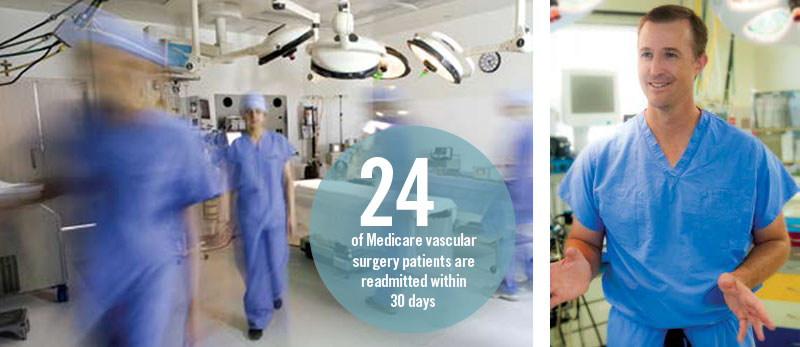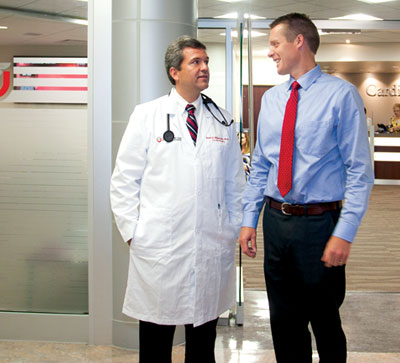The Care Continuum
Case Study One
Volume gets a bad rap these days, and focusing on market share seems old-school compared to the post-Affordable Care Act emphasis on value. But Cardiovascular Center Director Brent Wilson, M.D., Ph.D., believes that volume and market share were the necessary means to growing out of problems and into value. They were also a means to survival.
Five years ago, the cardiovascular service line (CVSL) faced a bleak reality. It was ranked number four in market share in the region. Specialists were siloed in their departments. Care was fragmented. Patient satisfaction scores fell below the 25th percentile nationally.
Then CVSL Medical Director John Michael, M.D., M.B.A., and Administrative Director Don Zarkou, M.B.A., both agreed: The old system, which had been in place for decades, was not the path forward. Michael wanted to hire people with experience and vision and rethink how the service line did business. Meetings with hospital administration were frequent and spirited. It became clear that success depended on a willingness to bridge the great divide between faculty and the health system, work together and trust one another. Wilson remembers Dan Lundergan, M.H.A., then executive director of University of Utah Hospital, saying, “We’ll support what the School of Medicine thinks is best.” Both sides took a leap of faith.
What followed was a complete transformation. “The entire structure was redesigned to provide seamless, efficient and coordinated care for patients,” says Outpatient CVSL Director Steven Tew, M.H.A., M.B.A. Together, hospital and School of Medicine leaders organized the medical assistants (MAs), previously hired by individual physicians, into a coordinated group practice. They created a central phone line staffed by MAs that offered a single, easy-to-access portal of entry for CV patients, many of whom have complex treatment plans that span multiple specialties. From shifting appointments, coordinating consecutive visits with multiple providers, and greeting patients when they arrive, MAs guide patients, a third of whom live more than 100 miles away, through every step of clinical care.
The Cardiovascular Center grew to more than 95 providers. “We looked for strong personalities who wanted to make a difference,” says Wilson. “Higher clinical volumes and diversity of patients opened up greater possibilities for both training and research.” It also allowed them to expand outreach, with cardiologists now seeing patients in more than 20 sites in five states.
Today, the CV service line is ranked No. 2 in market share, patient satisfaction has skyrocketed to the 85th percentile, and last quarter was the most clinically productive ever. “Volume, and alignment with the hospital, has done many good things for us and for our patients,” says Wilson.
Case Study Two

Benjamin Brooke, M.D., Ph.D., has all the right degrees from all the right schools (University of Virginia, Utah, Hopkins, Dartmouth). After 15 years of rigorous training, the path he chose as a vascular surgeon, however, is much less traditional. Today, you’re as likely to find him sitting in a focus group talking to patients about their recent surgery as you are to find him in the operating room performing a complicated bypass graft.
Defying the archetype of the surgeon who’s eager to hand off the patient’s care, Brooke has focused his research precisely on those transitions of care, from the clinic to the OR, to the ICU, to the floor, to a post-acute facility and back home.
Brooke splits his time evenly between his clinical practice and health services research. “I feel lucky to be here,” says Brooke, assistant professor of vascular surgery. “A lot of departments are so driven by productivity and clinical revenue, they would never allow surgeons to do this type of work.” Clearly, surgery generates more revenue than focus groups, but Vascular Surgery Division Chief Larry Kraiss, M.D., says the institution is taking the long view. “Eventually we’ll be held financially responsible for poor outcomes,” says Kraiss. “More importantly, we’re doing what’s right for the patient.”
Finding ways to improve processes is far more exciting to Brooke than economic incentives. But he doesn’t believe he’s unique. “All surgeons are interested in improving outcomes,” says Brooke. “No surgeon wants to have a patient readmitted because they weren’t given an anticoagulant at a post-acute care facility. You take it personally. It’s not trivial.” Brooke envisions a new paradigm where surgeons are not just technicians but comanagers of a patient’s health.
With funding from a Patient-Centered Outcomes Research Institute (PCORI) grant, he’s studying patient outcomes and gaps in care coordination. He talks to patients about the problems they experience and the opportunities they see to improve. “We need to ask patients what their goals are and then clearly communicate what they can expect.”
Collaborating with colleagues from across the country, he’s hoping his research will lead to changes that are scalable and widely disseminated. “Patients often become pawns in a big, complex structure,” says Brooke. “We need to look at the care we’re providing from their perspective.”




